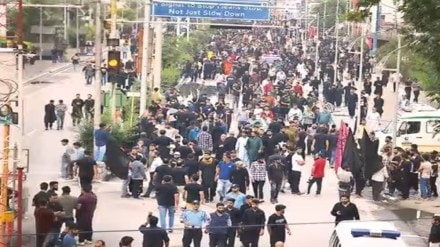By Farooq Wani
Ever since Pakistan sponsored militancy raised its ugly head in Jammu and Kashmir (J&K) during the late eighties, this region has invariably remained in the news, which unfortunately has been largely negative and tragic.
Due to terrorism related violence, not only have thousands of innocent civilian lives been lost, but the socio-economic mark-ups have also been crippled and reduced to the point of stagnancy. Frequent shutdown calls by separatists and terrorist activities only added to the economic woes of the ordinary Kashmiri as these disrupted normal life and discouraged tourists.
When the Government of India (GoI) abrogated Articles 370 and 35-A of the Indian constitution, most of the people belonging to J&K weren’t aware of the implications of this move. Taking advantage of this information void, unscrupulous people and organisations pursuing motivated agendas tried to push a false narrative claiming that this decision went against the interests of people of J&K.
However, in less than four years, people of J&K as well as Ladakh have realised that Article 370 abrogation has proved to be a boon for them as it has facilitated introduction of several people-oriented socio-economic schemes.
Alongwith a determined and sustained drive to improve the quality of life of the people through infrastructure and economic revival initiatives, the J&K Union Territory (UT) administration under Lt Governor Manoj Sinha is according due importance as regards fulfilling the religious aspiration of the people. His surprise of attending the Muharram procession in Srinagar on Saturday (July 29) was wholeheartedly welcomed by the people. Sinha’s Muharram outreach is particularly significant for four reasons.
Firstly, the procession to mark the solemn occasion of Muharram was allowed in the Kashmir Valley after more than three decades, which indicates that the security situation in Kashmir Valley has improved substantially. Secondly, this is for the first time that a head of government in J&K participated in a Muharram procession. Thirdly, the fact that a Hindu proudly participated in a significant event in the calendar of the Muslim community showcases Kashmir’s pluralistic Rishi-Sufi culture.
Lastly, by ensuring that the security and administrative arrangements for the Muharram processions were of the same standard as those undertaken for the Amarnath Yatra, Mata Vaishno Devi pilgrimage and Kheer Bhawani darshan, the UT administration of J&K has vindicated India’s ethos of religious equality.
However, while the Muharram procession in Srinagar has gone off well and the people are happy with the arrangements made by the administration to make this possible, the run-up to this event wasn’t a cakewalk. In a meeting chaired by J&K Lt Governor regarding the upcoming Muharram processions in the Valley, former minister and prominent Shia cleric Imran Reza Ansari walked out in protest of what he perceived to be ‘poor arrangements and insensitivity shown by the L-G administration’ and walked out.
The successful conduct of Muharram processions in Srinagar belie Ansari’s claim that the UT administration was insensitive towards the Shia community in Kashmir through a “new hybrid” administrative model dominated by “rogue variant” politico-bureaucrats. It also reveals the negative trend widely prevalent in J&K politics of trying to score brownie points by unnecessarily casting unfounded aspersions on the establishment. What’s even more appalling is that despite being a minister in the J & K government, Ansari himself never uttered a word in favour of allowing the people to take out Muharram processions!
Adorning the traditional black dress for this solemn event, Sinha undertook a visit to the Bota Kadal area of Srinagar, described as the most volatile part of J&K’s summer capital to offer a ‘chaddar’ to Zuljanah, paid homage to Hazrat Imam Hussain on the occasion and also distributed refreshments among the gathering. The Shia community has appreciated this gesture and praised the excellent arrangements made by the administration for Saturday’s Muharram procession, which culminated at the Zadibal Imambara in the city. “We feel delighted to see LG sahib among us today. It is a moment of pride for us. Arrangements made by the administration are up to the mark,” said one Shia mourner.
In a message which he delivered at a national convention on Sufism, Sinha said street violence, which was once synonymous with Kashmir, was now a thing of the past, and added that the people of Kashmir were now breathing with a greater sense of freedom. This was testimony to the return of peace and normalcy in J&K. Peace was necessary for development and the continued promotion of Kashmiri culture and its Sufi traditions, he said. The Governor of Kerala, Arif Mohammad Khan, who also attended the convention, said the teachings of revered Saint Sheikh-ul-Alam were being followed across the world and that is why “he is known as Sheikh-ul-Alam not Sheikh-ul-Kashmir”.
In the period upto 1988-89, the main Muharram procession in Srinagar started from Abi Guzar, passed through the walled city, and culminated at Zadibal, with the Ansari and Aga families leading it alternately. This procession attracted both Shia and Sunni mourners, with Sheikh Mohammad Abdullah, the former Prime Minister of the erstwhile state, calling for unity between the communities while he was alive.
The Muharram processions were finally stopped in 1988 as it coincided with the death of former Pakistan President Zia-ul-Haq. Militancy thereafter took root in J&K and in order to prevent terrorists creating a sectarian divide by targeting Muharram processions were disallowed. Permission to take out the Ashura procession is a positive development and a clear indication of normalcy returning to Kashmir. One hopes that the people of J&K will play their part in promoting peace and thereby help in restoring the glory of this paradise on earth!
The author is Editor Brighter Kashmir, Author, TV commentator, political analyst and columnist.
Disclaimer: Views expressed are personal and do not reflect the official position or policy of Financial Express Online. Reproducing this content without permission is prohibited.
